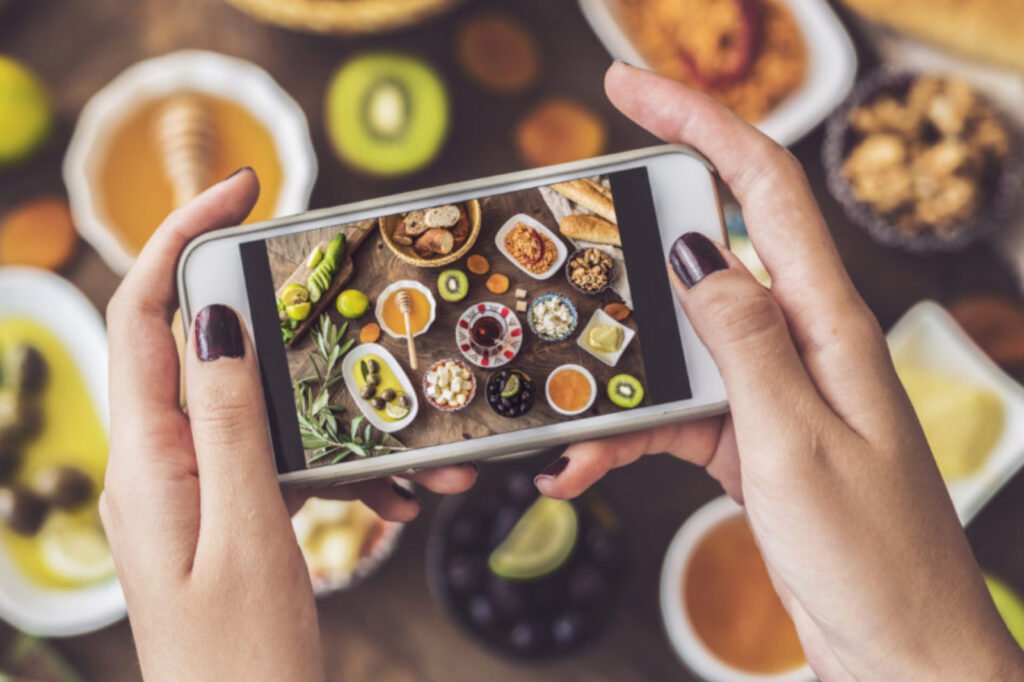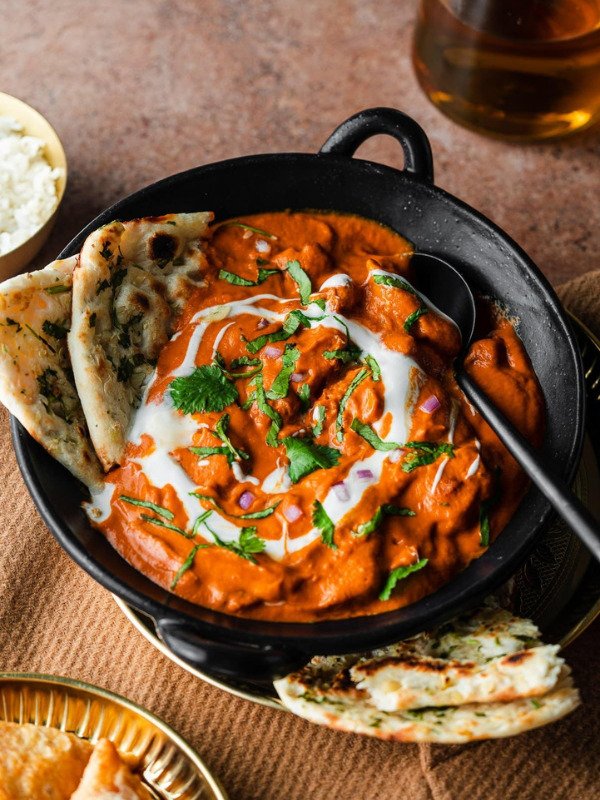From viral food trends to health-conscious cuisine- Discover how social media is shaping the future of food.

"
In this article, we will explore the impact of social media on food trends, explicitly focusing on the emergence of foodie culture and examining the positive and negative influences it has brought forth.
Let's dive right in..
Scrolling through Instagram, watching a thin crust, oozing mozzarella, woodfired pizza? Or maybe a soft, rich brownie with dribbling hot chocolate sauce? Or the trending Mutton Curry or the not-so-healthy Chicken Biryani cooked in Palm Oil.
And now you’re persuaded to ditch your diet and order it right away?
Trust me. We have all been there!
Social media has changed how we eat, from the recipes we try to the restaurants we visit. Instagram, TikTok, and Pinterest have all played a significant role in shaping the latest food trends. Social media has become a driving force behind the food industry’s evolution by providing food influencers and bloggers a platform to share their culinary creations.
In this article, we’ll delve into how social media has transformed our approach to food, from viral food challenges to health-conscious eating habits.
So sit back, grab a snack, and discover the exciting ways social media is shaping the future of food!
From Sustenance to Experience: The Emergence of Foodie Culture:
It’s been since the 1960s when people started showing greater interest in food beyond just sustenance. It began to be viewed as a cultural experience and an art form. The emergence of foodie culture has transformed how we approach food, from the ingredients we use to how we eat out.
Foodies are passionate about exploring new culinary experiences. This is driven by a desire to savour food as an art form, with an appreciation for the history, culture, and science behind the dishes we enjoy.
From Michelin-starred restaurants to street food vendors, foodies are changing the culinary landscape.
Let’s discover what led to the emergence of this foodie culture!
3 Reasons led to the emergence of the foodie culture:


1. Change in Lifestyle:
Lifestyle changes have fueled foodie culture, as people have become more adventurous and curious about different types of food. This includes a growing interest in food tourism. People travel to different destinations to try the local cuisine, such as visiting Italy for authentic pizza and pasta or visiting France to try French cuisines, such as Creme Brulle and pastries.
https://theoneliner.in/french-cuisine-vs-indian-cuisine/
A great example is the rise of food festivals and markets worldwide, seen in the Borough Market in London and the Night Noodle Markets in Australia, which showcase a range of diverse and unique food experiences.
Did you Know ?- Singapore has over 110 hawker centers, which are considered an “integral part of Singapore living,” one such hawker stall is Hill Street Tai Hwa Pork Noodle. This street-food vendor sells a Michelin-starred dish for 6 Singapore dollars!
2. Rise of Social Media:
Social media has played a significant role in the rise of foodie culture. Platforms like Instagram and TikTok have made it easier for food enthusiasts to connect, share their culinary experiences, and discover new food trends.
Food bloggers and influencers have amassed large followings by posting mouth-watering photos and videos of their creations, and many have even turned their passion for food into successful careers.
For example, food bloggers like Half Baked Harvest and Minimalist Baker have amassed millions of followers and regularly share their recipes online.
Moreover, the viral nature of the food challenge and hashtags, such as the #TikTokWrap trend, #avocadotoast, or #foodporn hashtags, have millions of posts on Instagram and gained colossal traffic throughout.


3. Interest in Health and Wellness:
A growing interest in health and wellness has shaped foodie culture. More and more people are seeking healthy, nutritious food that aligns with their dietary restrictions or ethical beliefs. This has led to a rise in plant-based diets and a growing trend towards whole foods and clean eating.
For example -The growing trend towards whole foods and clean eating, as people seek out unprocessed and nutrient-dense foods, like smoothies and grain bowls.
Overall, the emergence of foodie culture has been driven by a combination of lifestyle changes, social media influence, and a growing interest in health and wellness. These factors have transformed how we think about food and create a new culinary exploration and appreciation era.
Impact of Social Media on Food Trends:
Social media has had a profound impact on the way we interact with food. From food bloggers to Instagram influencers, online platforms have become a central hub for sharing recipes, restaurant recommendations, and food-related content. While social media has undoubtedly contributed to the rise of new food trends and increased awareness of healthy eating, it has also been criticized for perpetuating unrealistic beauty standards, fueling food envy, and contributing to food waste and overconsumption.
Let’s indulge in exploring social media's positive and negative impacts on food trends and examine how these impacts shape our relationship with food!
Positive Impacts of Social Media on Food Trends
Let’s dive right in!
1. Trend Towards healthy eating:
Social media platforms like Instagram and TikTok have allowed people to access information about healthy eating and nutrition more engagingly and interactively.
Maintaining a healthy lifestyle may sometimes become problematic when you crave variety and spice in your meals. That’s where social media comes in!
Users can follow accounts that promote healthy eating habits and learn about healthy recipes and the popularity of plant-based diets. They can also see visually appealing dishes that promote healthy living and inspire them to choose healthy food.
For example- The Compston Kitchen, The Budget Bytes, Natasha’s Kitchen, and many more can inspire and encourage you to move forward toward a healthier life.
2. Increased interest in home cooking and DIY food projects:
Social media has made it easier than ever to access recipes, cooking tips, and instructional videos, which has empowered people to take control of their own food choices and develop new skills in the kitchen.
This trend has also contributed to a greater appreciation for locally sourced and sustainable ingredients as people seek to create healthy and environmentally conscious meals.
Once you set out to explore these DIY food projects, you will be intrigued by your cooking skills, and artificially made expensive products won’t ever suffice.
For example- The homemade mozzarella trend, Banana oatmeal cake, Baked Tortilla chips, and many more exciting options.
You can see their recipe on allrecipes.com.
Trust me, there’s a lot, You just need to get your hands dirty!


3. Promotes Food Tourism:
Promoting food tourism is essential to social media’s impact on food trends. Social media platforms allow food bloggers, chefs, and food enthusiasts to share their culinary experiences worldwide, showcasing the diversity and richness of different cuisines and food cultures.
Some people who simply want to explore Street Food can travel to Lucknow only to explore Galouti kebabs and old Delhi Streets to try delicious Butter Chicken, Kulcha -naan, etc. People can even travel to Hyderabad only to try Hyderabadi Biryani from the well-known Paradise Biryani.
Ten Cities to Sample Street Food in India
Through social media, food enthusiasts can share their travel experiences, highlight local restaurants and markets, and provide recommendations for must-try dishes and ingredients. This helps to promote food tourism by encouraging people to explore new destinations and immerse themselves in the local food culture.
4. Awareness about food waste reduction:
Social media has played a crucial role in raising awareness about food waste reduction.
Have you ever wondered if the waste you throw after every time you cook a meal can be put to some use?
Through social media, organizations and individuals can share educational content, tips, and strategies for reducing and reusing food waste in homes, restaurants, and grocery stores.
For example, hashtags like #foodwaste, #scrappycooking, and #zerowaste have gained popularity on social media, creating a community interested in reducing and reusing food waste and sharing their experiences and tips with others.
But only some things that trend on Social Media are great!
Negative impacts of Social Media on Food trends:
1. Unrealistic Food Expectations:
“Food presentation can affect appetite: How food is presented can also impact appetite.
For example,” Research has shown that people tend to eat more when presented with larger portions or when food is arranged in an attractive way” -Brian Wansink – Professor at Cornell University and author of the book “Mindless Eating: Why We Eat More Than We Think.
The highly stylized and curated images of food that dominate social media platforms can create unrealistic expectations for how food should look and taste in real life.
The emphasis on visual appeal can also overshadow other essential aspects of food, such as taste, nutrition, and sustainability when people focus solely on how their food looks, they may prioritize appearance over these other factors, which can lead to unhealthy or unsustainable food choices.
It’s important to remember that the images we see on social media are often carefully curated and edited and may not reflect how food looks or tastes in everyday life. While seeing beautiful images of food can be inspiring, it’s also important to maintain realistic expectations and prioritize other essential factors like taste, nutrition, and sustainability.
2. Misinformation:
Social media can also be a source of misinformation about health and wellness. Users may promote fat diets or make false claims about the health benefits of certain foods or supplements, which can be misleading and potentially harmful.
People tend to get attracted by content presentations by various food bloggers and believe them blindly, not paying attention to the importance of double-checking the facts.
False or exaggerated claims about certain foods or diets can spread quickly on social media, leading to confusion about what is healthy or nutritious. This can be especially problematic for people with health conditions or those looking to make informed diet choices.
For example, numerous fad diets have been promoted on social media that make unrealistic claims about weight loss or health benefits. These diets may exclude entire food groups or rely on expensive supplements, despite a lack of scientific evidence supporting their efficacy.
Such misinformation can cause people to make unhealthy or unsustainable dietary choices that negatively impact their health and well-being.
"
Some companies using influencer marketing were found to disclose product dangers after presenting multiple images (i.e., burying warnings after entertaining content). Others presented claims in a way that would lead consumers to believe the product was FDA-approved when it was not.
-AMA Journal of Ethics
3. Encourages unhealthy habits:
Social media influencers and celebrities can use their platforms to promote unhealthy diets or products with little nutritional value. This can lead to people making unhealthy food choices or developing unrealistic expectations about what constitutes a healthy diet.
Furthermore, social media can contribute to normalizing disordered eating behaviors, such as restrictive eating or over-exercising, which can negatively impact physical and mental health.
For example, social media platforms can be used to share images of skinny bodies or to promote extreme weight loss methods that can be dangerous or unhealthy.
4. Misleading Nutritional Information:
Another common issue with nutrition advice on social media is the demonization, i.e., the wrong portrayal of certain foods or food groups. Some influencers may label perfectly fine food items as unhealthy or harmful, misleading their followers.
We all must have heard people say, “Carbohydrates are bad for you,” or, “Gluten is toxic and should be avoided at all costs.” However, these claims are not supported by scientific evidence.
They can be harmful if people start eliminating entire food groups from their diets without proper guidance from a qualified nutritionist or doctor.
For example -some influencers may portray fruit as too high in sugar and advise their followers to limit their intake or avoid it altogether, even though fruits are an excellent source of vitamins, minerals, and fiber. Similarly, dairy products like milk, cheese, and yogurt may be labeled as unhealthy or even harmful, despite being a significant source of calcium, protein, and other essential nutrients.
It’s important to remember that a balanced and varied diet that includes a range of food groups is usually the healthiest approach to nutrition.
Read more about these myths - Top Nutrition Fallacies on Social Media
Final Thoughts
Hey, you see how social media has changed the way we eat? It seems like every other day, there’s a new food trend or diet craze making the rounds.
While it’s great to have access to so much information and inspiration, we must be careful about the nutrition advice we encounter online.
At the same time, we are responsible for seeking out reliable sources of nutrition information and making informed choices based on our needs and preferences.
As consumers, we can shape future food trends by promoting accurate, balanced, and sustainable nutrition messages.
So let’s keep the conversation going and work towards a healthier, happier world, one meal at a time!
Subscribe to new post
The One Liner
Useful Links
Order Related Queries
Useful Links
Order Related Queries










